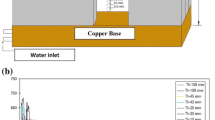Abstract
Studies are made of changes in the porosity and structure of a hard alloy obtained by hot pressing and sintering within a broad range of temperatures (950-1450°C). The effect of solid- and liquid-phase annealing on their porosity and structure is also examined. It is shown that the hot-pressed specimens are denser than the sintered specimens within the solid-phase region, other conditions being equal. Solid-phase annealing of hot-pressed and sintered specimens increases the density of both types of specimens, but the annealing operation is more effective in the former case. It is established that the open pore channels are 2-3 times smaller in the hot-pressed specimens than in the sintered specimens and are no larger than the average size of the tungsten carbide particles. Active growth of the carbide particles and redistribution of the ductile phase are observed even in the solid phase. The carbide particles grow considerably faster (by a factor of four) at sintering temperatures above 1200°C.
Similar content being viewed by others
REFERENCES
M. S. Koval'chenko, A. V. Laptev, L. F. Ochkas, and L. N. Gudym, Hard Alloys Based on Tungsten Carbide [in Russian], Institute for Problems of Materials Science, National Academy of Sciences of Ukraine, Kiev (1993), Report on Patent Research No. 312.
Yao Li and Yang Chaochem, “Effect of refractory carbide additions on the characteristics of the binder phase in WC – ??Co hard alloys,” Adv. Powder Met. and Particul. Mater: Proc. Powder Met. World Congress (San Francisco, Calix, June 21-26, 1992), Princeton, N.Y. (1992), Vol. 8, pp. 61-69.
Li Jinyao, Zhon Guizhi, and He Ping, Powder Metall. Technol., 13, No. 1, 44-47 (1995).
A. Bock, W. Schubert, and B. Lux, “Inhibition of grain growth on submicron cemented carbides,” Powder Metall. Int., 24, No. 1, 20-26 (1992).
Akira Egami, Masaya Ehira, and Masahiro Machida, Kobe Seiko Giho (Kobe Steel Eng. Repts.), 44, No. 2, 63-66 (1994).
J. Inada and H. Yoshimura, “Material properties and end milling performance of WC –10% Co –0.75% Cr3C2 micrograin cemented carbide,” Proc. 13th Int. Plansee Seminar, Metallwerk Plansee, Reutte (1992), Vol. 2, pp. 67-79.
L. E. McCandlish, B. H. Kear, and B. K. Kim, “Processing and properties of nanostructural WC – Co,” Nanostruct. Mater., 1, No. 2, 119-124 (1992).
W. D. Schubert, A. Bock, and B. Lux, “Central aspects and limits of conventional ultrafine WC powder manufacture and hard metal production,” Proc. 13th Int. Plansee Seminar, Metallwerk Plansee, Reutte (1993), Vol. 4, pp. 283-305.
K. S. Chernayvskii, Stereology in Metals Science [in Russian], Metallurgiya, Moscow (1977).
N. Tsuchiga, M. Fukuda, T. Nakai, and H. Suzuki, “Some properties of WC – Co alloy prepared by solid phase sintering,” J. Jpn. Soc. Powd. and Powder Met., 37, No. 8, 1177-1180 (1990).
C. Colin, L. Durant, N. Favrot, et al., “Comparative study of the densification and properties of WC – Co cermets processed by liquid-phase sintering and solid-state sintering,” Proc. 13th Int. Plansee Seminar, Metallwerk Plansee, Reutte (1993), Vol. 4, pp. 505-521.
V. V. Skorokhod and Yu. M. Solonin, “Ratio of local to integral consolidation during the sintering of porous bodies,” Poroshk. Metall., No. 12, 25-30 (1983).
A. K. Butylenko and V. N. Sokolovskii, “Consolidation of carbides of tungsten, titanium, and their mixtures with nickel during heating under high pressure,” Poroshk. Metall., No. 7, 28-32 (1981).
A. F. Shchurov, A. M. Shiryaev, and A. M. Kotkis, “Fracture toughness of brittle materials,” in: Applied Problems of Strength and Ductility [in Russian], Gor'k. Univ., Gorky (1981), pp. 108-113.
A. S. Drachinskii, A. E. Kushchevskii, et al., “Effect of porosity on the fracture toughness of powder iron,” Poroshk. Metall., No. 12, 80-84 (1982).
A. A. Sotnik, A. D. Vasil'ev, and I. G. Slys, “Effect of porosity on the fracture toughness of brittle powder materials,” in: Electron Microscopy and the Strength of Materials [in Russian], Institute for Problems of Materials Science, National Academy of Sciences of Ukraine, Kiev (1989), pp. 34-40.
V. E. Perel'man, “Analysis of the consolidation of powder materials during cubic compression,” Poroshk. Metall., No. 9, 15-20 (1977).
Author information
Authors and Affiliations
Rights and permissions
About this article
Cite this article
Laptev, A.V. Structural Features and Properties of Alloy 84% WC ― 16% Co, Obtained by Hot Pressing in the Solid and Liquid Phases. Part 1. Effect of the Temperature at which the Specimens are Prepared on Their Density and Structure. Powder Metallurgy and Metal Ceramics 39, 607–617 (2000). https://doi.org/10.1023/A:1011388400293
Issue Date:
DOI: https://doi.org/10.1023/A:1011388400293




